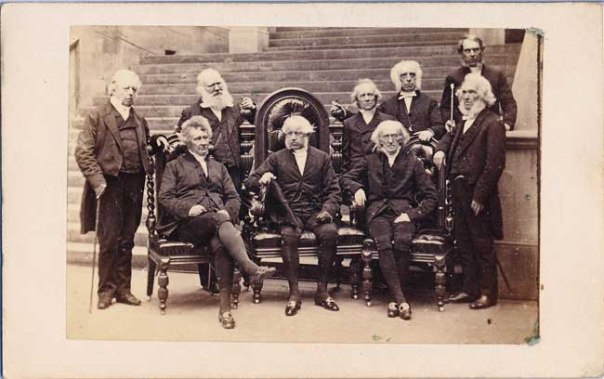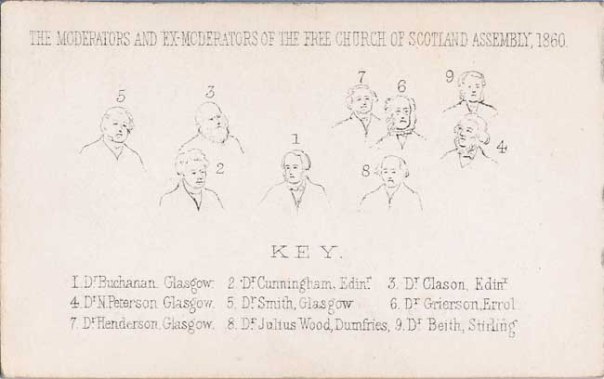At the PCA Historical Center, our research library is a vital part of our collections. In particular, this library provides context and background material for the records and manuscript collections that are the focus of the Historical Center. As such, the library consists largely of works about American Presbyterianism, but in recent years, we’ve also begun to add materials from foreign shores, with an understandable emphasis on Presbyterianism in Scotland.
Just a few years ago, I was able to add an original photograph from 1860 to our collection, one in which all of the then-living moderators and ex-moderators of the Free Church of Scotland are shown seated together. It is an amazing photograph.
I was pleased then when early today, a friend pointed to the web site of the Free Church of Scotland, where they have displayed the work of a Turkish artist who has colorized this same photo from 1860. The artist is named Tolga Unker, and as the FCS web site states, he is, “a Turkish based artist with a keen interest in Scottish church history, has used his talents to bring to life a black and white photograph of Free Church of Scotland Moderators captured in 1860. The digitally colourised image, taken in New College on Edinburgh’s Mound, shows nine moderators who served from 1848-1860.
So take a look at the photo now preserved at the PCA Historical Center, and in the second image below, from the back of the photo, look over the key which identifies the subjects of the photo. Below that, we’ve added a bit more information, including the life dates of each of the men pictured. Then finally, click the link (below) which takes you to the Free Church site. Open that link in a new tab and then jump back and forth to compare the photos.
https://freechurch.org/news/turkish-artist-gives-life-to-old-photograph
You will probably notice that our photo is slightly different, a second shot taken by the photographer that day. But note especially how colorization brings the subjects to life. And lastly, as you ponder this group of faithful servants of the Church, let this remind you to pray for your pastors, elders and teachers. These are trying times, and they need your support.
Pictured, as per the key published on the reverse, with their year of service as moderator:
1848 – Dr. Patrick Clason, Buccleuch Parish Church, Edinburgh [1789-1867]
1850 – Dr. Nathaniel Paterson, Glasgow [3 July 1787 – 25 April 1871]
1853 – Dr. John Smith, Glasgow [? – ?]
1854 – Dr. James Grierson, Errol [? – 5 May 1875]
1855 – Dr. James Henderson, Glasgow [1797 – 1874]
1857 – Dr. James Julius Wood, Dumfries [1800 – 1877]
1858 – Dr. Alexander Beith, Stirling [13 January 1799 – 11 May 1891]
1859 – Dr. William Cunningham, Edinburgh [2 October 1805 – 14 December 1861]
1860 – Dr. Robert Buchanan, Glasgow [1802 – 1875], moderator in 1860
For that date range 1848-1860, three former moderators were not present for inclusion in the photograph, namely Drs. Mackintosh Mackay [1793-1873], of Dunoon (1849), Alexander Duff [15 April 1806 – 12 February 1878], Calcutta (1851) and Angus Makellar, who had died the year previous to when the photograph was taken [22 June 1780–10 May 1859], Edinburgh (1852).
You are currently browsing the archive for the May 2020 category.
The First Chaplain to the House of Representatives
by Rev. David T. Myers
In a day when everyone is decrying our young people’s lack of knowledge of our American republic, try this question on yourself. Who was the nation’s first chaplain elected to the United States House of Representatives? If you answered the Rev. William Linn, of Pennsylvania, a member minister of the Presbyterian Church, give yourself ten bonus points.
His years were February 27, 1752 to January 8, 1809. We don’t know much about his background, but early on, this ardent and most impassioned minister, as he was called by his contemporaries, graduated from the College of New Jersey (later on Princeton Theological Seminary) in 1772. Ordained by the Donegal Presbytery three years later, he found himself in the perilous days leading up to the American Revolution. He became the chaplain of the Continental Army, and as far as we know, proclaimed the Scriptures faithfully to men of that military unit.
After his military chaplaincy years, he served for seven years the Scotch-Irish members of the Big Spring Presbyterian Church in present day Newville, Pennsylvania. His ministerial call took him next to the Maryland as the principal of an academy for four years. It was on May 1, 1789, that he was elected as the first chaplain of the United States House of Representatives in Washington, D.C.
The members of Congress, having begun meetings of the Continental Congress every day in prayer, obviously wanted to have that spiritual ministry continued in both the Senate and the House. William Linn prayed each day for the members of the U.S. House of Representatives, or arranged guest chaplains for the post, counseled with the members of the House, officiated at funerals and even performed marriages on occasion. In what would today be called a violation of the separation of church and state, Rev. Linn held worship services in the chamber for Congressional members and their families, alternating with the Senate chaplain every other week.
After this ministry, and two other Presbyterian ministers consecutively replaced him as House chaplain, William Linn became a trustee and later on President pro temp of the Queens College, later on renamed Rutgers University. He is listed down as the first president of Rutgers University.
He went on to meet His Maker and Redeemer at the age of 55 in 1809, after a successful ministry in the military, in the church, in government, and education.
Words to Live By: We may not know all of God’s servants who have been faithful in His kingdom down through the years, but we need to realize that we must be ready to serve Him in any capacity as He opens the door of service. Are you ready?
by Rev. David T. Myers
In a day when everyone is decrying our young people’s lack of knowledge of our American republic, try this question on yourself. Who was the nation’s first chaplain elected to the United States House of Representatives? If you answered the Rev. William Linn, of Pennsylvania, a member minister of the Presbyterian Church, give yourself ten bonus points.
His years were February 27, 1752 to January 8, 1809. We don’t know much about his background, but early on, this ardent and most impassioned minister, as he was called by his contemporaries, graduated from the College of New Jersey (later on Princeton Theological Seminary) in 1772. Ordained by the Donegal Presbytery three years later, he found himself in the perilous days leading up to the American Revolution. He became the chaplain of the Continental Army, and as far as we know, proclaimed the Scriptures faithfully to men of that military unit.
After his military chaplaincy years, he served for seven years the Scotch-Irish members of the Big Spring Presbyterian Church in present day Newville, Pennsylvania. His ministerial call took him next to the Maryland as the principal of an academy for four years. It was on May 1, 1789, that he was elected as the first chaplain of the United States House of Representatives in Washington, D.C.
The members of Congress, having begun meetings of the Continental Congress every day in prayer, obviously wanted to have that spiritual ministry continued in both the Senate and the House. William Linn prayed each day for the members of the U.S. House of Representatives, or arranged guest chaplains for the post, counseled with the members of the House, officiated at funerals and even performed marriages on occasion. In what would today be called a violation of the separation of church and state, Rev. Linn held worship services in the chamber for Congressional members and their families, alternating with the Senate chaplain every other week.
After this ministry, and two other Presbyterian ministers consecutively replaced him as House chaplain, William Linn became a trustee and later on President pro temp of the Queens College, later on renamed Rutgers University. He is listed down as the first president of Rutgers University.
He went on to meet His Maker and Redeemer at the age of 55 in 1809, after a successful ministry in the military, in the church, in government, and education.
Words to Live By: We may not know all of God’s servants who have been faithful in His kingdom down through the years, but we need to realize that we must be ready to serve Him in any capacity as He opens the door of service. Are you ready?



